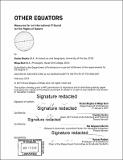| dc.contributor.advisor | Hashim Sarkis and Roi Saigueiro Barrio. | en_US |
| dc.contributor.author | Binjaku, Xhulo. | en_US |
| dc.contributor.author | Dixit, Milap. | en_US |
| dc.contributor.other | Massachusetts Institute of Technology. Department of Architecture. | en_US |
| dc.date.accessioned | 2019-10-11T21:59:56Z | |
| dc.date.available | 2019-10-11T21:59:56Z | |
| dc.date.copyright | 2019 | en_US |
| dc.date.issued | 2019 | en_US |
| dc.identifier.uri | https://hdl.handle.net/1721.1/122518 | |
| dc.description | Thesis: M. Arch., Massachusetts Institute of Technology, Department of Architecture, 2019 | en_US |
| dc.description | Cataloged from PDF version of thesis. Pages 166 and 167 blank. | en_US |
| dc.description | Includes bibliographical references (pages 164-165). | en_US |
| dc.description.abstract | In 1997, the Kyoto Protocol institutionalized carbon offsetting as a "market solution" to emissions, allowing companies and states to offset every tonne of carbon dioxide emissions with an equivalent tonne of carbon dioxide sequestered somewhere else. This logic of equivalence was enabled by a set of global metrics (such as the definition of "forest" under international law) that financialized the Earth's capacity to absorb carbon. Equatorial mountains became prime targets for the production of carbon credits through pine and eucalyptus plantations. In 2008, Ecuador became the first country to recognize the Rights of Nature, extending its jurisdiction to the scale of the planet and granting legal personhood to nonhuman entities such as mountains. More than a decade since it was first recognized, the Rights of Nature remains an elusive notion, easily absorbed into the logic of practices that reduce Nature to its exchange value. | en_US |
| dc.description.abstract | The Rights of Nature lacks an institution to specify and guarantee its functions, to measure and account for its violations, and to summon the "Nature" for whom it claims to speak. In 2018, Ecuador requested proposals for an International Tribunal with the authority to invoke universal jurisdiction for global cases related to the Rights of Nature. The Tribunal would be deployed territorially across a site of planetary significance: the Equator itself, which intersects the Avenue of Volcanoes, a group of twenty mountains recognized as legal persons under Ecuadorian law. The buildings of the institution make mountains legible as witnesses in courts of law by framing, measuring and collecting "units" of Nature to be used as evidence. They are the architectural expression of a paradox that underlies the very idea of the Rights of Nature: that the infinite value of Nature has to be assigned finite values in order to exist as a legal category. | en_US |
| dc.description.abstract | The legal and spatial logics used to define units of "Nature" begin to erode when they encounter the specificity of terrain, allowing the mountains to speak for themselves. | en_US |
| dc.description.statementofresponsibility | by Xhulio Binjaku, Milap Dixit. | en_US |
| dc.format.extent | 167 pages | en_US |
| dc.language.iso | eng | en_US |
| dc.publisher | Massachusetts Institute of Technology | en_US |
| dc.rights | MIT theses are protected by copyright. They may be viewed, downloaded, or printed from this source but further reproduction or distribution in any format is prohibited without written permission. | en_US |
| dc.rights.uri | http://dspace.mit.edu/handle/1721.1/7582 | en_US |
| dc.subject | Architecture. | en_US |
| dc.title | Other equators : measures for an international tribunal for the Rights of Nature | en_US |
| dc.title.alternative | Measures for an international tribunal for the Rights of Nature | en_US |
| dc.type | Thesis | en_US |
| dc.description.degree | M. Arch. | en_US |
| dc.contributor.department | Massachusetts Institute of Technology. Department of Architecture | en_US |
| dc.identifier.oclc | 1121277557 | en_US |
| dc.description.collection | M.Arch. Massachusetts Institute of Technology, Department of Architecture | en_US |
| dspace.imported | 2019-10-11T21:59:55Z | en_US |
| mit.thesis.degree | Master | en_US |
| mit.thesis.department | Arch | en_US |
